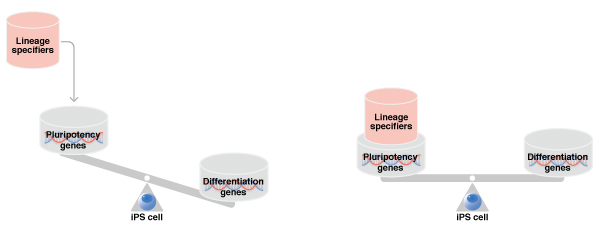
News & Events
News & Events
News
July 01, 2016
Differentiation promotes pluripotency

Scientists at CiRA show genes that promote differentiation can be used to induce pluripotency.
Genes highly expressed in embryonic stem (ES) cells are thought to be associated with pluripotency. Accordingly, when scientists reprogram cells to induced pluripotent (iPS) cells, they normally target the same genes. Yet the reprogramming efficiency is frustratingly low. CiRA scientist Tatsuya Yamakawa believes one reason is that limiting the genes to those of ES cells ignores a much larger population that could aid in the reprogramming. "I think the factors in reprogramming and pluripotency maintenance are different," he said.
The reason is the seesaw model. "The seesaw model suggests lineage specifiers could be used for cell reprogramming," explains CiRA Junior Associate Professor Keisuke Okita. Lineage specifiers are genes that promote cell differentiation, which one would intuitively expect to hinder cell reprogramming. Yamakawa and Okita, however, reasoned that expressing specifiers for one lineage could balance the expression of specifiers for another lineage, like a seesaw, thus keeping the cell in a pluripotent state.
To prove this theory, the group investigated over 2000 genes, an exhaustive number, to find non-pluripotency genes that could contribute to the reprogramming. One reason most researchers do not consider differentiation genes is that the analysis is simply too demanding, but Yamakawa claimed that equipment at CiRA made the analysis more manageable. After compiling a list of candidates they settled on two, HHEX and HLX. "HHEX and HLX are well studied in differentiation," said Yamakawa. "I thought it would be interesting for further analysis." Indeed, the researchers found that activating either gene could increase the efficiency by a magnitude. Interestingly, the two genes had an inclination to initiate reprogramming, but to antagonize the maintenance, suggesting that they should only be activated for a transient period.
Along with running his own lab at CiRA, Okita is heavily involved in CiRA's grand aim of building a clinical-grade iPS cell bank for patient care. He expects these findings to assist in this project and that the large-scale gene analysis will help him find other candidates. "We are looking for genes that can improve the reprogramming process to make better iPS cells."
Paper Details
Journal: Stem Cells (2016)
Title: Screening of Human cDNA Library Reveals Two Differentiation-related Genes, HHEX and HLX, as Promoters of Early Phase Reprogramming Toward Pluripotency
Authors: Tatsuya Yamakawa1, Yoshiko Sato1, Yasuko Matsumura1, Yukiko Kobayashi1, Yoshifumi Kawamura2, Naoki Goshima3, Shinya Yamanaka1,4 andKeisuke Okita1
Author Affiliations:
- Center for iPS Cell Research and Application, Kyoto University, Kyoto, Japan
- Japan Biological Informatics Consortium, Tokyo, Japan
- Molecular Profiling Research Center for Drug Discovery, National Institute of Advanced Industrial Science and Technology, Tokyo, Japan
- Gladstone Institute of Cardiovascular Disease, San Francisco, CA, USA






















